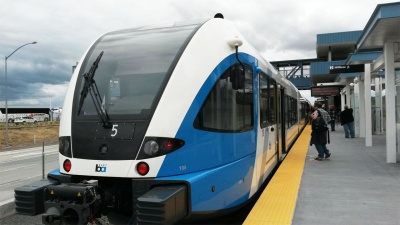Difference between revisions of "EBART"
(Created page with "{{lowercase title}} 400px eBART, officially known as BART to Antioch, refers to the eastern segment of the {{BARTlines|yellow|y}} line between Antioch and...") |
m |
||
| Line 3: | Line 3: | ||
[[File:Ebart.jpg|400px]] | [[File:Ebart.jpg|400px]] | ||
| − | eBART, officially known as BART to Antioch, refers to the eastern segment of the {{BARTlines|yellow|y}} line between Antioch and Pittsburg/Bay Point. This segment uses standard-gauge diesel multiple unit trains rather than wide-gauge electric trains so they're not compatible with the main BART system. A transfer platform is built just east of the main Pittsburg/Bay Point platform to permit timed cross platform transfers between both trains. | + | eBART, officially known as '''BART to Antioch''', refers to the eastern segment of the {{BARTlines|yellow|y}} line between Antioch and Pittsburg/Bay Point. This segment uses standard-gauge diesel multiple unit trains rather than wide-gauge electric trains so they're not compatible with the main BART system. A transfer platform is built just east of the main Pittsburg/Bay Point platform to permit timed cross platform transfers between both trains. |
The reason to implement diesel trains on the eastern segment is the significant cost reduction compared to building a regular BART line, in a low-density environment where long subway-like trains are not justified. | The reason to implement diesel trains on the eastern segment is the significant cost reduction compared to building a regular BART line, in a low-density environment where long subway-like trains are not justified. | ||
Latest revision as of 01:42, 30 May 2018
eBART, officially known as BART to Antioch, refers to the eastern segment of the Antioch - SFO line between Antioch and Pittsburg/Bay Point. This segment uses standard-gauge diesel multiple unit trains rather than wide-gauge electric trains so they're not compatible with the main BART system. A transfer platform is built just east of the main Pittsburg/Bay Point platform to permit timed cross platform transfers between both trains.
The reason to implement diesel trains on the eastern segment is the significant cost reduction compared to building a regular BART line, in a low-density environment where long subway-like trains are not justified.

